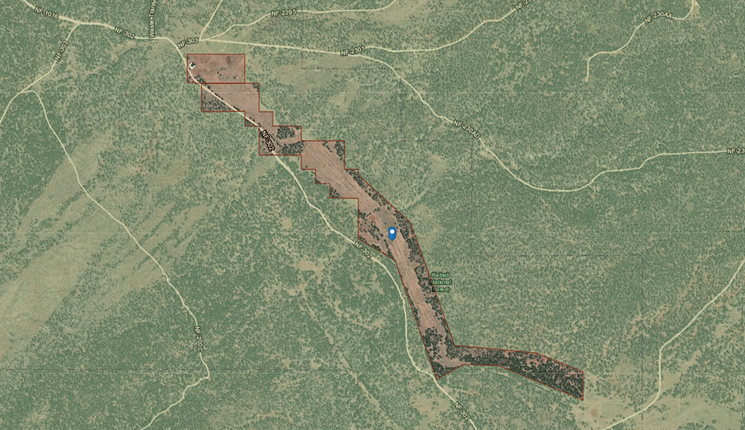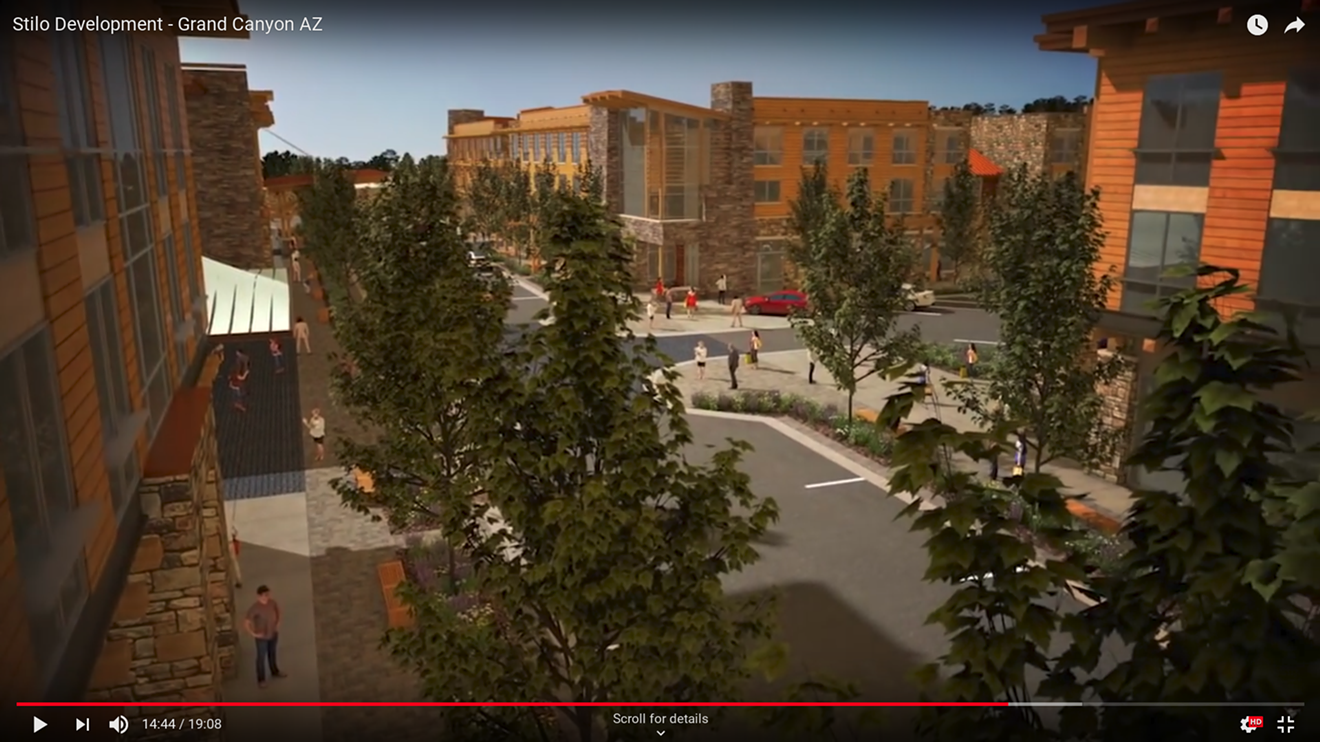On Thursday night, the Tusayan Town Council voted unanimously to approve a revised proposal for roads and utility easements connecting to parcels of land they own that are surrounded by the Kaibab National Forest.
Stilo, the developer and co-applicant, owns the vast majority of those parcels, the 200-acre Ten-X Ranch and 160-acre Kotzin Ranch. Tusayan owns 20-acre portions of each. The town, whose economy is tightly bound with tourism at nearby Grand Canyon National Park, is home to roughly 600 people and sits two miles from the south entrance to the park.
The town and Stilo could submit the proposal to the Kaibab National Forest as soon as Friday.
Brady Harris, Tusayan's vice mayor, told Phoenix New Times it would happen "within the next week."
The Forest Service rejected Tusayan and Stilo's first application in 2016 for a special-use authorization. If the agency accepts this one, it will advance to an environmental review, the first step in a lengthy process of public discussion and input under the National Environmental Policy Act.
Last September, Tusayan and Stilo submitted a "significantly altered" proposal to Heather Provencio, the Kaibab National Forest supervisor.
"We have worked hard to make sure this proposal would result in appropriate development for our community and reduce visitor impacts on Grand Canyon National Park," they wrote in that proposal's cover letter.
The Forest Service reviewed the proposal, and in October, it requested additional information from Tusayan and Stilo, said Jackie Banks, a spokesperson for the Kaibab National Forest.
About a month ago, representatives from both the town and company met with Kaibab National Forest Service staff, Harris said.
“We had a nice meeting with them and, kind of, walked through what the proposal would look like," he said. He denied that the Forest Service had offered advice about how to tweak the proposal to increase its chances of passage.
Rather, they walked through the area that would be affected and talked about using only existing roads to minimize disturbances in the Kaibab National Forest, he said.
Banks said that officials with the Kaibab National Forest and the town had met several times, saying that doing so is typical for the permit that Tusayan and Stilo are seeking.
"Forest Service policy provides that Forest Service officials should be in communication with proponents for special uses throughout the pre-application process," she said.
After those meetings, the revised proposal shifted one of the proposed roads to Kotzin Ranch northward, away from an area with a school, to what Tusayan and Stilo said "generally follows only already existing roads and trails."
Alicyn Gitlin, who oversees the Sierra Club's Grand Canyon program, told New Times she had traveled the roads and trails proposed as roads to Kotzin on Thursday, prior to the town council meeting, and found that some were barely passable.
The Forest Service would have to reopen others, she added, and “they’re going to have to do some blasting, at least in one spot.” Campers would also be displaced, she said, noting that she'd seen four groups who were camping there — on a Thursday afternoon in the dead of winter.
Gitlin also worried that the new proposal did not adequately protect the area's groundwater.
The proposal promises that commercial water needs — which during peak season, would be 275,000 gallons a day — would have to be hauled in by truck. It still allows "residential uses" to be met by pumping groundwater.
In the proposal, Stilo offered to agree to a "complete prohibition" on commercial groundwater use, except in the event of "technological breakthroughs resulting in proven zero-impact upon groundwater resources."
It suggested a restrictive covenant or a conservation easement to enforce that restriction, but it's not clear who would be responsible for that enforcement.
Harris said he did not know but that "it’d probably ultimately come down to the town or the Forest Service.”
Gitlin said she had spoken with Kaibab National Forest Supervisor Heather Provencio on Thursday, and that Provencio told her it would not be the Forest Service.
During the public comment portion of Thursday's meeting, before the town council unanimously agreed on the revised proposal, Gitlin asked the council to send the proposal back to Stilo.
"This is a death sentence for springs in the Grand Canyon," she said, asking the council to think about future generations. “You have the power to defer this, to say no.”
Banks said that once the Forest Service receives the proposal, the agency would evaluate it to check that it meets Forest Service requirements, before deciding on whether to allow it to advance.
Um, What Development?
Stilo's planned, massive developments would dramatically reshape the area near the South Rim of the Grand Canyon, conservation groups and members of the public have warned. In May, a Twitter thread warning about those plans brought scrutiny to the town and criticism from across the country went viral.In a report prior to Thursday's council meeting, Tusayan Town Manager Cyndia Seelhammer included negative attention as the lone drawback of submitting the proposal.
"This submittal will bring a great deal of attention to the Town," the report said. "In the past there were many objections from across the country, often based on faulty or incomplete understanding of the proposal."
Responding to that kind of attention took time and energy, "which detracts from the other work of the Town," the report said.

Both Stilo and the town of Tusayan own land at Ten-X Ranch, a nearly 200-acre parcel east of Tusayan, marked here as the brown strip with a blue tag...
Coconino County Assessor's Office
He and staff "spent more than 9 hours taking call, after call, after call," he wrote. New Times obtained the email through a Freedom of Information Act request.
Duthie responded to those viral tweets, whose details were not entirely accurate but whose overall point was, by saying that Tusayan was not in the process of deciding on a massive development, the Arizona Republic reported.
Harris declined to comment on the town's response to the tweets, which in hindsight seem misleading, if not outright lies.
“The town is trying to create a much more transparent process and make sure that we’re open to discussion," Harris said, noting that Duthie is no longer the town manager. "I don’t have direct comment on what happened in previous times.”
He acknowledged the stress that this project has put on Tusayan.
“We’re a small town," he said."A lot of people have a hard time adjusting to the pressure and the microscope that you get put under.”
Tusayan terminated its contract with Duthie in October.

...and zooming in shows that Stilo owns about 175 acres of it, and the town of Tusayan just 20 (the rectangle at the top).
Coconino County Assessor's Office
That number, the proposal said, represented a 33 percent reduction from what zoning would have legally allowed them to build, in what appeared to be a concession "to alleviate concerns over indirect effects of the proposed action," according to the town.
Stilo rendered its overall vision in a video produced several years ago, showing resorts, hotels, and "edutainment centers."
According to Harris, Stilo doesn't "have any rock solid plans yet."
He said he could not speak on behalf of the Tusayan Town Council as to whether it supports Stilo's vision, adding that he personally didn't really have an opinion either way on what Stilo wanted to do.
He declined to comment on the video and whether he would support having the massive developments the company showed in the video in Tusayan's backyard, but said he would support "something along the lines of a hotel or a cultural center" to teach visitors about the history of tribes in the area.
Two representatives of Stilo did not return phone calls and text messages from New Times seeking comment for this story.
The Future of Tusayan
Tusayan officials say the town needs the easements and roads to its two 20-acre holdings in Kotzin and Ten-X ranches in order to build more homes for its own residents.The fact that housing in Tusayan is company-owned has stymied the town's growth and investment, Harris said, because people have little incentive or ability to invest in or build their futures in Tusayan.
Right now, the town has officially planned to build 54 single-family houses on its parcels, but Harris said he wanted to see more affordable housing, like townhomes, "something that the everyday person here can afford." He suggested offhand that that might mean 200 houses.
Asked how people in Tusayan feel about the prospect of giant hotels, maybe a shopping mall or two, perhaps a casino, in their backyard, Harris waffled.
"People are very supportive of the housing," he said, adding that it was his job as council member "to make sure that development in the future is going to be right for Tusayan."
In 2017, Tusayan rejected a ballot measure to allow buildings up to 65 feet tall, but the town, or at least the 131 people who voted, were deeply divided over the matter. Sixty people supported the proposed height increase, and 71 opposed it.













